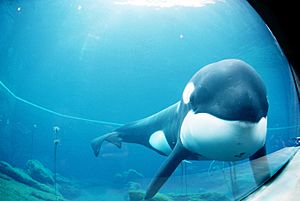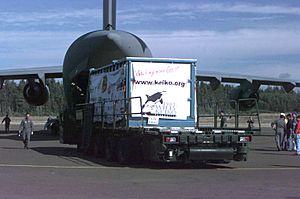Keiko (orca) facts for kids

Keiko at the Oregon Coast Aquarium
|
|
| Species | Orca (Orcinus orca) |
|---|---|
| Breed | Icelandic |
| Sex | Male |
| Born | c. 24 September 1976 Near Iceland |
| Died | 12 December 2003 (aged c. 27) Arasvikfjord, Norway |
| Notable role | Willy in Free Willy |
| Weight | 11,500 lb (5,200 kg) |
Keiko (earlier Siggi and Kago; c. 24 September 1976 – 12 December 2003) was a male orca captured in the Atlantic Ocean near Iceland in 1979. He portrayed Willy in the 1993 film Free Willy. In 1996, Warner Bros. and the International Marine Mammal Project collaborated to return Keiko to the wild. After years of preparing Keiko for reintegration, Keiko was flown to Iceland in 1998 and in 2002, became the first captive orca to be fully released back into the ocean. On 12 December 2003, he died of pneumonia in a bay in Norway at the age of 27.
Contents
Early life
Keiko was captured near Reyðarfjörður, Iceland in 1979 at the approximate age of two and sold to the Icelandic Aquarium in Hafnarfjörður. At the time, he was named Siggi, with the name Kago given at a later date.
In 1982, he was sold to Marineland in Ontario, Canada. At this new facility, he first started performing for the public and developed skin lesions indicative of poor health and was also bullied by older orcas. Keiko was then sold to Reino Aventura, an amusement park in Mexico City, Mexico, in 1985.
At Reino Aventura, he was given the name "Keiko", a feminine Japanese name that means "lucky one". At the time, he was only 10 feet long and was housed in a tank intended for bottlenose dolphins.
Free Willy
Keiko became the star of the film Free Willy in 1993. The publicity from his role led to an effort by Warner Bros. to find him a better home. The pool for the now 21-foot-long orca was only 22 feet deep, 65 feet wide and 114 feet long. He was housed with bottlenose dolphins, but no others of his own species. Keiko was underweight for his size, and the water temperature was often too warm, which contributed to various skin problems. Due to a papillomavirus infection, Keiko experienced skin outbreaks, first observed while he was housed in Ontario, Canada, prior to his transfer to Mexico City, which complicated both his candidacy for relocation and for eventual release into the wild.
Free Willy-Keiko Foundation
Outcry for Keiko's liberation arose from the film's credits containing a phone number for whale preservation that received hundreds of thousands of call-ins. Warner Brothers and Craig McCaw approached the International Marine Mammal Project for help, which established the Free Willy-Keiko Foundation in February 1995. With donations from the foundation and millions of school children, the Oregon Coast Aquarium in Newport, Oregon was given over $7 million to construct facilities to return him to health with the hope of eventually returning him to the wild. Reino Aventura donated Keiko to the Foundation. Before he left the amusement park in Mexico City, Keiko performed for the public for the last time, and was seen off by thousands of children, with more onlookers watching his overnight journey to the Mexico City International Airport. At the time he weighed about 7,700 pounds (3493 kg). A C-130 cargo plane donated by United Parcel Service (UPS) hauled Keiko to Newport, Oregon on January 8, 1996.
On arrival in Oregon, Keiko was housed in a new (2,000,000 US gallons (7,600,000 L)) concrete enclosure containing seawater. His weight had increased significantly by June 1997, to 9,620 pounds (4364 kg).
Re-introduction to the wild
The plan to return him to the wild was a topic of much controversy. Some felt his years of captivity made such a return impossible. Researchers in a scientific study later said attempts to return him to the wild were unsuccessful, but that monitoring him with radio and satellite tags was part of "a contingency plan for return to human care," which secured "the long-term well-being of the animal." Others considered his release misguided. The Norwegian pro-whaling politician Steinar Bastesen made international news for his statement that Keiko should instead be killed and the meat sent to Africa as foreign aid.
Nevertheless, the process of preparing Keiko for the wild began on 9 September 1998, when he was flown to Klettsvík, a bay on the island of Heimaey in Vestmannaeyjar, Iceland. UPS again participated in transport, this time by providing ground transportation to the nearby Newport Municipal Airport. Keiko was transported in a specialized 30-foot-long container filled with enough saltwater to cover him and cooled with ice cubes. He was then transported by air in a C-17 Globemaster airplane loaned by the U.S. Air Force. Upon landing at Vestmannaeyjar Airport, the C-17 Globemaster aircraft suffered a landing gear failure causing over $1 million in damage, though Keiko was unharmed.
His day-to-day care became the responsibility of the Free Willy-Keiko Foundation with management assistance from the Ocean Futures Society. He was initially housed in a pen in the Klettsvik Bay where he underwent training designed to prepare him for his eventual release, including supervised swims in the open ocean.
Ocean Futures left the Keiko project in late 2001. The Free Willy-Keiko Foundation and The Humane Society of the United States re-established management of the project at that time until Keiko's death in 2003. Keiko was fully free by the summer of 2002 and departed Icelandic waters in early August following some orcas but not integrated with the pod. His journey was tracked via the signal from a VHF tag attached to the dorsal fin. About a month later, he arrived in Norway's Skålvik Fjord, apparently seeking contact with human beings and allowing children to ride on his back. His caretakers relocated to Norway and continued to conduct boat-follows with Keiko for the next 15 months. On the basis of girth measurements and blood tests, it was assumed that Keiko had fed during his 900-mile (1500 km) journey from Iceland to Norway. Keiko occasionally approached groups of wild orcas, but remained on the periphery, at distances of 100–300 meters (109 to 328 yards), with his head pointing toward the closest orca.
Death
Keiko died in Taknes Bay, Skålvikfjord, Norway, while swimming in the fjords on 12 December 2003, at the age of 27. Pneumonia was determined as his probable cause of death.
Evaluation of the re-introduction process
Most sources conclude that the project to free Keiko was a failure because the orca failed to adapt to life in the wild. In Norway, Keiko had little contact with other orcas and was not fishing; for months before his death, the whale was being fed daily.
According to an article in New Scientist, "He was seen diving among the wild orcas only once, on 30 July 2002. And after physical contact at the surface, Keiko swam away, seeking out human company on the tracking boat". A scientific study published in the journal Marine Mammal Science (July 2009) confirms that he was seen on the periphery of some wild groups but was never seen to be socially integrated with such whales. In summary, "He never integrated into a wild pod ... and could not break his need for human contact." His return to humans for food and for company confirms the failure of the project according to the same scientific study.
Reasons cited for Keiko's failure to adapt include his early age at capture, the long history of captivity, prolonged lack of contact with conspecifics and strong bonds with humans.
In spite of those comments, David Phillips, executive director of the Free Willy-Keiko Foundation, praised the release project: "We took the hardest candidate and took him from near death in Mexico to swimming with wild whales in Norway". "Keiko had five years with the sights and sounds of natural seawater. I think it was a great success in terms of Keiko, his well-being, and the whole world that wanted to do the right thing." Others also claim that the release was a success, and The Huffington Post called it a "phenomenal success ... giving him years of health and freedom".
The total cost of freeing Keiko was about US$20 million.
An alternative to freeing orcas after long-term captivity, is the use of a "sanctuary" or "oceanic enclosure" (sea pen), according to Lori Marino of the Whale Sanctuary Project. "They can’t be released, but their quality of life can be improved by orders of magnitude", Marino said in a 2016 interview where she agreed that the cost would be high ($15 to $20 million). "It’s a solemn responsibility, and it’s the best we can do for animals that are in captivity."
Filmography
In 2010 the film Keiko: The Untold Story was released. In 2013 a New York Times video, The Whale Who Would Not Be Freed, included interviews about Keiko's return to the ocean.
- Quinceañera (1987; TV series)
- Keiko en peligro (1990)
- Free Willy (1993)
- Azul (1996; TV series)
- Keiko: The Untold Story (2010)
- The Whale Who Would Not Be Freed (2013)
See also
 In Spanish: Keiko (orca) para niños
In Spanish: Keiko (orca) para niños
- List of individual cetaceans


